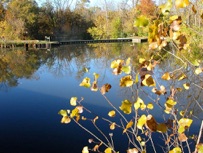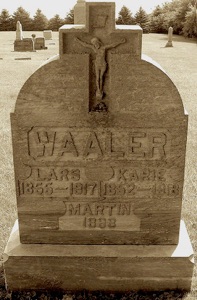A Practical Joke Gone Wrong •••••••••••••
Great story from 1832 Indiana that could have easily turned tragic. A miller and his Potawatomi Indian friends played a practical joke on a couple of farmers by the name of Langdon and Gage. It almost led to a massacre before the truth became known. The story takes place in LaGrange County, which is just west of Steuben County.
I’ve seen speculation that Gideon might be the Langdon in this story. It’s certainly possible, but I believe there were a number of other Langdons in the area at that time. I'm not sure we can ever say with any certainty that he was involved, but it’s obvious that he would have at least been aware of it.
Click Image for larger view.
“When the Langdons lived in Beloit they had to go 15 miles down the river to have their corn ground, or “cracked”, as they called it in those days. On one of these trips Mr. Langdon found the Mill broken down and he was gone four days. While he was gone his family nearly starved, the mother managed to grind enough meal in her coffee mill to keep the children alive.”
Here are links to the article from the 25 Aug 1909 Beloit News:
LINK Page 1 • LINK Page 2 • LINK Page 3
LINK to the Article on Wisconsin Historical Society Website.
Gage Marries Langdon •••••••••••••••••••••
An interesting side note is that Gideon’s brother Hiram married a Gage in LaGrange County in 1839.
Name: Hiram Langdon
Spouse: Nancy Gage
Date: 23 Jun 1839
County: LaGrange
State: Indiana
Source: County Court Records at Lagrange, IN
Gage and Langdon War Part 1 ••••••••••••
Source: 1882 COUNTIES OF LaGRANGE and NOBLE INDIANA HISTORICAL and BIOGRAPHICAL • Chicago F.A. Battey and Company Publishers 1882
GREENFIELD TOWNSHIP By: Weston A. Goodspeed
Improvements went on very rapidly during the years 1830, 1831 and 1832. Nearly or quite all the prairie land was broken up and fenced off into farms, and homes were established in the surrounding woods. At last, when the township was surveyed and the land thrown into market, a great rush was made by an army of anxious squatters to secure the land they had partially improved, and upon which they then lived. It was during the Black Hawk war (summer of 1832) that the citizens of Greenfield and surrounding townships were thrown into a fever of fear by what is remembered as "The Gage War."
Two men, named respectively Gage and Langdon, went one day to the mill in the northern part of Springfield Township. Before this, considerable talk had been indulged in concerning the probability of the Indians arising in war against the settlers, as large bands were then in the county, and the border struggle farther west was not unknown to them. This talk prepared the minds of the settlers for what was to follow. Gage, Langdon, the miller and others at the mill renewed the gossip, continuing it until late at night, when the former two retired with some serious misgivings in their minds.
After they had gone to bed, it was resolved by three or four at the mill to give them an "Indian Scare" early the next morning. Two or three, or perhaps more, assisted by several Indians, dressed themselves in full Indian war costume, with war paint and blanket and tomahawk, etc. The next morning, while Gage and Langdon were talking in front of the mill with the miller, a large Indian suddenly showed himself from behind a tree near by, and, raising his rifle quickly, fired, and the miller fell to the earth apparently in the agonies of death,exclaiming, "My God, the Indians! I'm shot!" The Indian who had apparently shot the miller and one or two others came leaping forward, swinging their tomahawks and yelling like demons.
Gage and Langdon instantly fled from the scene at the top of their speed, Gage going north in the excitement, and Langdon south. They made excellent time across the country, informing every one they saw that the Indians were coming, that they had shot all at the mill, and were sweeping out through the surrounding country. The result may be readily imagined. The most intense excitement prevailed, and families fled in every direction.
Gage reached Lexington, and the families in that neighborhood gathered at the blacksmith shop of George Donaldson, into which the women and children were thrust, while the men began to fell trees and cut logs, for the purpose of hastily building a fort (afterward called Fort Donaldson). Families living in the western part hastily resolved to fortify the island in Cedar Lake. There they fled, and began the work of constructing the fort. Many very interesting incidents occured, but, within a day or two, the delusion was dispelled. The logs cut for "Fort Donaldson" remained at the spot for many years. More of this interesting event will be found in other chapters.
Gage and Langdon War Part 2 ••••••••••••
Source: 1882 COUNTIES OF LaGRANGE and NOBLE INDIANA HISTORICAL and BIOGRAPHICAL • Chicago F.A. Battey and Company Publishers 1882
SPRINGFIELD TOWNSHIP By: Weston A. Goodspeed
The originators or perpetrators of the Indian scare, known as the "Gage and Langdon war," were the Frenchman Druryeaur, the Irishman O'Ferrell, the Yankee Brownell, the German miller, and a few native Americans. Such a unity of nationality could not fail to produce a sensation. All persons at the time were talking about the Black Hawk war, and speculating as to the probability of trouble with the Pottawatomies. Those easily frightened saw dreadful times ahead, and were ready for the scare. The details are told in the chapter on Greenfield.
Langdon fled to Brushy Prairie, and told the few settlers there of the massacre at the mill. Men for miles around armed themselves and repaired in haste to the spot, to assist in quelling the outbreak. Over one hundred assembled, though, for some reason unknown, no organization was effected. About seventy-five Indians were encamped near by. They thought the whites were going to attack them, and hung out the white flag. In truth, the settlers could hardly be restrained from firing upon them.
It was not long before the truth became known,and then the perpetrators of the hoax were treated to an exhibition of wrath and indignation. So hostile were the settlers to the jokers that trade at the mill, the distillery and the store languished. Under this pressure, the Frenchman left the place; and very likely the early disappearance of O'Ferrell, and the sale of the property of Brownell were hastened, if not caused, by their perpetration of the joke. Do not say the story is magnified. When 100 men assemble, armed and prepared for fight; when attempts are made to build forts and garrison islands in lakes, that section of the country is in earnest and means business. Such are the facts, at least.
Links to Book •••••••••••••••••••••••••••••••••
Here’s a link to the book in “Open Library”. You can read it online, download it to a kindle or any number of other formats.
"Counties of LaGrange and Noble, Indiana : historical and biographical"
Here’s a text version of the story on “Rootsweb”.
LINK to part 1 • LINK to part 2
Cedar Lake Fortification ••••••••••••••••••••
If you view Cedar Lake in Satellite View, it looks like you can see the fortifications they made. Everything is underwater due to a dam that raised the water level.
Click Image for larger view.
Here’s a link to a post about the area in Spokesrider. Cedar Lake.
Mongo Building from the Story •••••••••••
The Library of Congress has some interesting documents about one of the buildings that seems to have played a part in the story. It’s still around and is known as the John O'Ferrell Store. “The Irishman O'Ferrell” was one of the perpetrators of the prank.
Click Image for larger view.
Significance: One of the first commercial structures in Langrange County, Indiana, the building was a focal point in the early events and history of Mongo. Built as a general store, it also served as post office, distillery outlet, and even informal courtroom during its history. The building is a good example of 19th century construction techniques and detail.
Here’s one of the data pages describing the history of the building.
History of the building with great historic drawings and photos. 2.5MB PDF.






